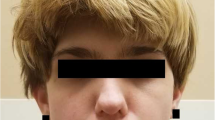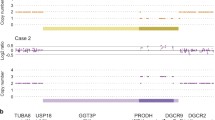Abstract
DiGeorge anomaly/velocardiofacial syndrome (DG/VCFS), called 22q11.2 deletion syndrome in general, is the most common chromosomal deletion syndrome found in humans. Typical facial features, palatal defects, conotruncal abnormalities of the heart, aplasia/hypoplasia of the parathyroid glands and of thymus are characteristics of this syndrome. Deletions of chromosome 22q11.2 (del22q11.2) are the leading causes of DG7VCFS. We report on a systematic search by fluorescence in situ hybridization (FISH) for deletions of chromosomes 22q11.2 in patients with a clinical suspicion or diagnosis of DG/VCFS. Using FISH we studied a series of 43 patients with suspected DG/VCFS. In this study, a total of 43 patients were investigated for the presence of a 22q11.2 deletion over a two-year period. Del22q11.2 was detected in 5 of the 43 patients tested. All patients with deletion had hypocalcemia, 80% had cardiac defects, 40% had facial dysmorphism, 40% had immunodeficiency , and 20% had otolaryngeal abnormalities. Chromosome 22q11.2 deletion is a relatively common condition and is readily diagnosed by FISH. We suggest that FISH analysis of 22q11.2 deletion should be performed in the presence of combined of hypocalcemia and congenital cardiac malformations, with or without any characteristics of the disease. This may facilitate an early diagnosis in such patients.


Similar content being viewed by others
References
DiGeorge AM (1968) Congenital absence of the thymus and its immunologic consequences: concurrence with congenital hypoparathyroidism. In: Bergsma D (ed) Birth defects original article series, vol 4. National Foundation March of Dimes, White Plains, pp 116
Ryan AK, Goodship JA, Wilson DI, Philip N, Levy A, Seidel H et al (1997) Spectrum of clinical features associated with interstitial chromosome 22q11 deletions: a European collaborative study. J Med Genet. 34(10):798–804
Hong R (1998) The DiGeorge anomaly. Semin Hematol 35:282–290
Shprintzen RJ Goldberg RB, Young D, Wolford L (1981) The velo-cardio-facial syndrome a clinical and genetic analysis. Pediatrics 67:167–172
Shprintzen RJ, Wang F, Goldberg R, Marion R (1985) The expanded velo-cardio-facial syndrome (VCF): additional features of the most common clefting syndrome. (Abstract). Am J Hum Genet 37: A77
Matsuoka R, Kimura M, Scambler PJ, Morrow BE, Imamura S, Minoshima S et al (1998) Molecular and clinical study of 183 patients with conotruncal anomaly face syndrome. Hum Genet 103:70–80
OMIM: http://www.ncbi.nlm.nih.gov/entrez/query.fcgi?DB=pubmed
Scambler PJ, Kelly D, Lindsay E, Williamson R, Goldberg R, Shprintzen R (1992) Velo-cardio-facial syndrome associated with chromosome 22 deletions encompassing the DiGeorge locus. Lancet 339:1138–1139
Cuneo BF (2001) 22q11.2 deletion syndrome: DiGeorge, velocardiofacial, and conotruncal anomaly face syndromes. Curr Opin Pediatr 13:465–472
Jawad AF, McDonald-Mcginn DM, Zackai E, Sullivan KE (2001) Immunologic features of chromosome 22q11.2 deletion syndrome (DiGeorge syndrome/velocardiofacial syndrome). J Pediatr 139:715–723
Vitelli F, Morishima M, Taddei I, Lindsay EA, Baldini A (2002) Tbx1 mutation causes multiple cardiovascular defects and disrupts neural crest and cranial nerve migratory pathways. Hum Mol Genet 11:915–922
Tobias ES, Morrison N, Whiteford ML, Tolmie JL (1999) Towards earlier diagnosis of 22q11 deletion. Arch Dis Child 81:513–514
Demczuk S, Aurias A (1995). DiGeorge syndrome and related syndromes associated with 22q11.2 deletions. Ann Genet 38:59–76
De la Chapelle A, Herva R, Koivisto M, Aula P (1981) A deletion in chromosome 22 can cause DiGeorge syndrome. Hum Genet 57:253–256
Taylor SC, Morris G, Wilson D, Davies SJ, Gregory JW (2003) Hypoparathyroidism and 22q11 deletion syndrome. Arch Dis Child 88:520–522
Jerome LA, Papaioannou VE (2001) DiGeorge syndrome phenotype in mice mutant for the T-box gene, Tbx1. Nat Genet 27:286–291
Huang RY, Shapiro NL (2000) Structural airway anomalies in patients with DiGeorge syndrome: a current review. Am J Otolaryng 21:326–330
Kilic SS, Gurpinar A, Yakut T, Egeli U, Dogruyol H (2003) Esophageal atresia and tracheo-esophageal fistula in a patient with Digeorge syndrome. J Pediatr Surg 38:E21–23
Markert ML, Hummell DS, Rosenblatt HM, Schiff SE, Harville TO, Williams LW, Schiff RI, Buckley RH (1998) Complete DiGeorge syndrome: persistence of profound immunodeficiency. J Pediatr 132:15–21
Matsumo T, Amamoto N, Kondoh T, Nakayama M, Takayanagi T, Tsuji Y (1998) Complete DiGeorge syndrome treated by bone marrow transplantation. Bone Marrow Transpl 22:927–930
Markert ML, Boeck A, Hale LP, Kloster AL, McLaughlin TM, Batchvarova MN, Douek DC, Koup RA, Kostyu DD, Ward FE, Rice HE, Mahaffey SM, Schiff SE, Buckley RH, Haynes BF (1999) Transplantation of thymus tissue in complete DiGeorge syndrome. New Engl J Med 341:1180–1189
NovelliA, Sabani M, Caiola A, Digilio MC, Giannotti A, Mingarelli R, Novelli G, Dallapiccola B (1999) Diagnosis of DiGeorge and Williams syndromes using FISH analysis of peripheral blood smears. Mol Cell Probe 13:303–307
Author information
Authors and Affiliations
Corresponding author
Rights and permissions
About this article
Cite this article
Yakut, T., Kilic, S.S., Cil, E. et al. FISH investigation of 22q11.2 deletion in patients with immunodeficiency and/or cardiac abnormalities. Ped Surgery Int 22, 380–383 (2006). https://doi.org/10.1007/s00383-006-1641-8
Accepted:
Published:
Issue Date:
DOI: https://doi.org/10.1007/s00383-006-1641-8




